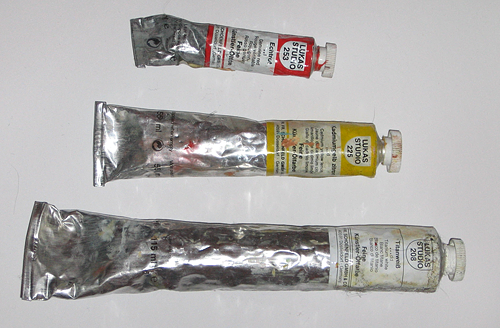This guide apeals primarily to those who pick up the oil tube for the first time. You will learn the basics of painting with oil colours and what equipment you will need to paint.
First I will describe the material. That means everything you need to start painting like paints, solvents, brushes etc. Then follows a step-by-step guide, in which I will describe how to paint a complete oil painting. The step-by-step guide is completed not yet and now you can always watch how far my picture already is.
This should be the foundation to learn the painting with oil paints. Have fun reading!
Beware! When oil paints are dried you won't get them out of your clothes - but also if the paints are not dryed you will have problems to get them out. The fact that the paints dry very slowly means that you have got a lot of time to bring the paints from your fingers to your clothes :oD . So take care!
I think you should not save money at the colors but always buy quality. When you are only starting to paint with oil you can resign to buy a large range of different hues. The basic colors, black, white and possibly some additional colors might be quite enough.

As allready told, the oil colours dry very slowly. Thus you can mix colours into your painting a longer time. That can be advantageous if you are painting a colour gradient or if you need to do some corrections. Furthermore the colours are waterproof dryingn paints. That means that you can paint over your painting again and again.
To paint with oil paints bristle brush are very qualified, because you can arrange the pastose oil colours very good on the painting ground with them.
With a broad synthetic brush you can attach glazes and make colour gradients over larger areas.
With smaller synthetic brushes you can paint small color gradients and create details in your painting. Thin martens-hair brushes are qualified for details as well.
The palette knife looks very similar to the painting knife, but they are used for mixing the paint on the palette and cleaning the palette. But you can also paint with them on the painting ground.
Painting knifes are used to apply the color directly on the painting ground. You can paint with the painting knife itself as well. Painting with the painting knife is a special technique and it has its own effects (compared to the brush).
Ordinary canvas serves as a painting ground if you paint with oil paints (there can also others painting grounds be used such as stone, glass, wood, etc.). For the quick start you get best a primed canvas from a department store or dealer.
The notorious palette. You can probably say that the palette is one of the greatest symbols of painting. On the palette the colors are mixed. But you can also use other accessories to mix the paint. A simple wooden board or a paper is doing it in a case of need too.
If you want to you can use an easel to work more comfortable. But you don't need it necessarily. So if you just start with a painting, you can save the money for easel and paint on the floor or the desk (like I do).
There is a relatively large variety of painting mediums for different purposes. Mainly we need turpentine to make the oil paint workable and to clean the brushes. There are different turpentine with several properties e.g. for fast-drying oil paints, slow-drying oil paints, mild smelling turpentine, special turpentine for cleaning brushes, etc. In addition there are painting mediums that delay the drying time of oil paint and much more.
Personally, I only use a citrus turpentine (that smells mild; normal turpentine smells rather unpleasant) and a stronger turpentine to clean the brushes. In my opinion is this equipment enough to paint with oil colours.
This website is about how to draw and paint. You will learn to use pencil and brush and how to drawn and paint your own pictures.